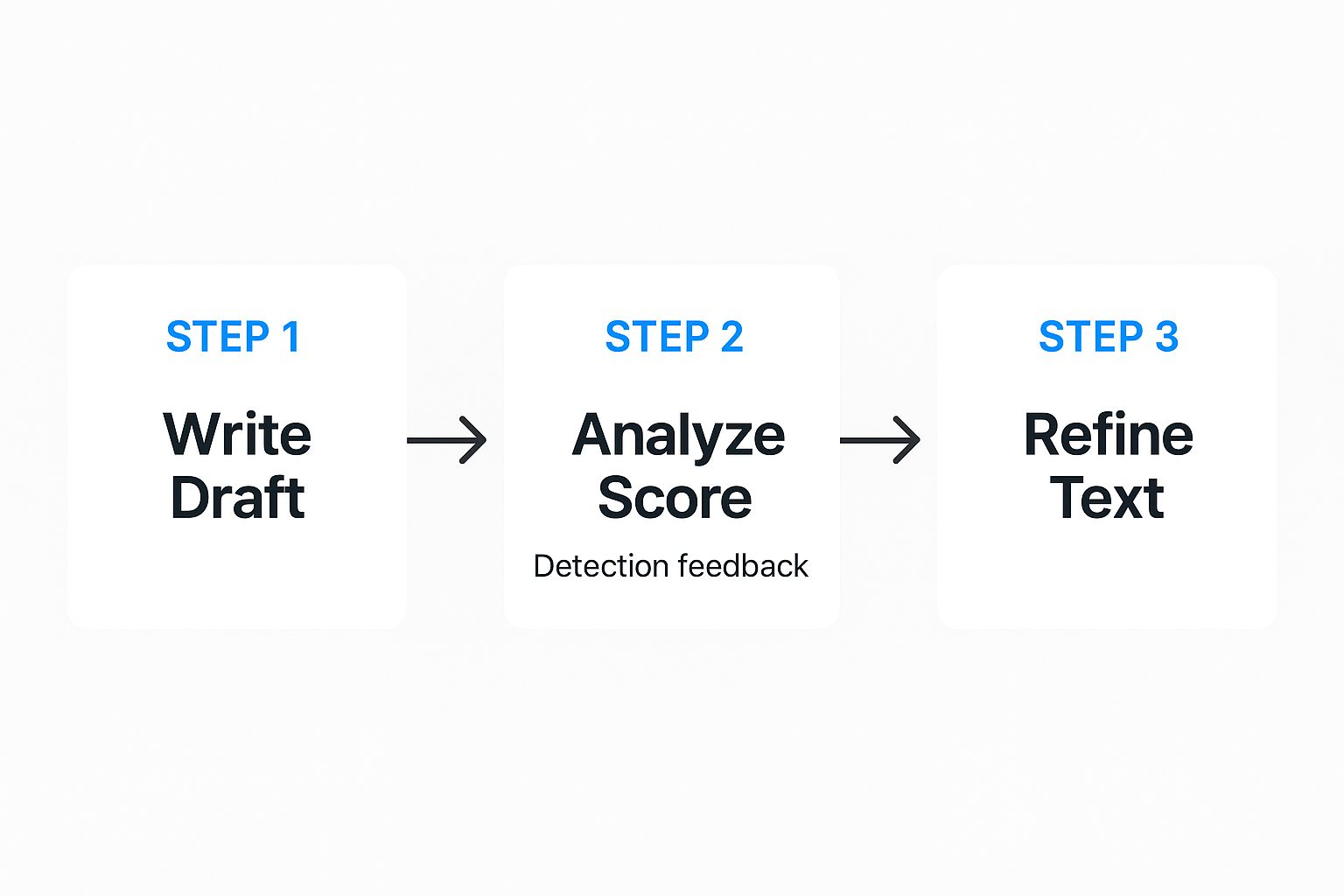How to Make ChatGPT Undetectable a Practical Guide

So, you want to make your ChatGPT content fly under the radar. The whole process really boils down to two things: rewriting the text to change up its phrasing and structure, and then running it through a checker to be sure. This one-two punch is how you strip out the predictable, robotic patterns that AI spotters are built to find, leaving you with content that reads like a human wrote it.
Why Bypassing AI Checking Matters

Let's get one thing straight: the push to make AI text unnoticeable isn't about pulling a fast one. It’s a practical move in a world that’s changing at a very fast pace. From college campuses to corporate marketing teams, people are figuring out smart ways to combine AI’s power with a necessary human touch.
For a lot of people, it all comes down to efficiency. Content creators and marketers are under constant pressure to churn out a ton of material. AI is brilliant for getting a first draft on the page fast, but that raw output usually lacks the personality and warmth needed to actually connect with a reader. On top of that, search engines are getting better at rewarding content that feels authentic and genuinely helpful, not something that sounds like it was spat out by a machine.
Academic and Professional Motivations
Things get a little more complicated in academic circles. Students are often stuck between using these powerful new tools and navigating institutional rules that haven't quite caught up yet. For most, the goal isn't to cheat. It's to use AI as a souped-up research helper or a tool to bust through a stubborn case of writer's block. Figuring out how to ethically weave AI-created ideas into their own writing is quickly becoming a critical skill. We actually dive deeper into this topic in our guide that asks whether it is okay to use ChatGPT to write a paper.
The sheer number of people using these tools is what's really driving the need for unnoticeable text.
Think about it: ChatGPT is now seeing over 810 million weekly users and processing more than 2.5 billion daily queries. With that kind of volume, the drive to rework and humanize its output is massive. This constant interaction creates an ongoing arms race, with both AI writing and the spotters built to find it getting smarter every day.
People want to use AI for all sorts of reasons, but their motivations for making the text unnoticeable are often quite specific.
Common Reasons for Making AI Text Unnoticeable
| User Group | Primary Motivation | Desired Outcome |
|---|---|---|
| Students | To use AI as a study aid without triggering academic integrity flags from outdated policies. | Submit original work that benefits from AI-assisted research and brainstorming. |
| Marketers | To scale content creation while making sure it resonates with audiences and ranks well in search engines. | High-quality, engaging content that feels personal and avoids SEO penalties. |
| Writers & Bloggers | To speed up the writing process (drafting, outlining) while preserving their unique voice and style. | Maintain creative control and authenticity, using AI as a productivity tool. |
At the end of the day, it's all about making sure the final product doesn't just pass a test but genuinely connects with the intended reader.
The Quest for Authenticity
The core motivation here is a simple desire for authenticity. It doesn't matter if you're writing a blog post, a term paper, or a marketing email—the goal is always to communicate clearly and effectively. Straight out of the box, AI-created text often feels a bit cold and impersonal.
Here’s a quick breakdown of why different people are looking to humanize their AI content:
- Students need to use AI as a learning tool without getting flagged by academic integrity software that can be overly aggressive or just plain wrong.
- Marketers have to produce content at scale that still feels personal, builds trust with customers, and performs well with search engine algorithms.
- Writers and Bloggers want to keep their unique voice and style intact while using AI to get past the blank page and speed up their workflow.
The real goal isn't just about tricking a checking tool. It’s about finding that perfect balance—using AI as a powerful helper while making sure the final piece of writing is original, engaging, and undeniably human.
Peeking Behind the Curtain: How AI Checkers Work
Before you can make your AI-created text fly under the radar, you need to know what you're up against. AI checkers don't just "read" your content. They're programmed to hunt for specific statistical patterns and fingerprints that give away machine-written text.
Think of it this way: these checking tools are built on a massive library of both human and AI writing. Over time, they learn to spot the subtle, almost invisible tells that models like ChatGPT leave behind.
A real person's writing is full of quirks. We use contractions, our sentence lengths vary wildly, and our phrasing isn't always perfectly polished. AI models, on the other hand, often produce text that’s just a little too perfect. It’s the consistent structure and predictable word choices that act like a digital breadcrumb trail right back to the AI.
The Specific Clues AI Checkers Hunt For
Deep down, AI checking really boils down to two key metrics: perplexity and burstiness.
- Perplexity is just a fancy way of measuring how predictable or complex your text is. Human writing usually has high perplexity because we pull from a huge vocabulary and don't always choose the most obvious word.
- Burstiness looks at the rhythm and flow of your sentences. Humans naturally mix short, punchy statements with longer, more detailed ones. We have bursts of complexity followed by simple thoughts.
AI-created text often scores low on both fronts. The words are common (low perplexity) and the sentences are frustratingly uniform in length (low burstiness). To get the full picture of why these patterns emerge, it helps to understand how ChatGPT indexes content in the first place.
This whole field is a constant cat-and-mouse game. As soon as a new way to humanize text appears, checkers are updated to spot it. Staying ahead means knowing the rules of the game.
This back-and-forth has pushed AI checkers to become incredibly sharp, boasting near-zero false positive rates. They’ve been built on such diverse text examples that the old tricks just don't work anymore.
The Smart Way to Humanize Your Content
You could spend hours manually editing your text, trying to inject these human-like variations. Or, you can use a tool built for the job.
This is exactly where a specialized humanizer comes in. A purpose-built tool does far more than a simple synonym-swapper. It intelligently reworks sentence structures, introduces more natural vocabulary, and smooths out that robotic stiffness that AI is known for.
By fundamentally changing the text's statistical patterns, it helps you sidestep checking while making sure the output is 100% plagiarism-free. The end goal isn't just about fooling an algorithm; it's about creating content that actually connects with a human reader. That's how you create work that's not only unnoticeable but genuinely more effective.
Practical Techniques to Humanize Your Writing
Alright, this is where the theory ends and the real work begins. Making AI text sound human is all about reintroducing the natural imperfections and stylistic quirks that language models are built to smooth over. It's less about trying to trick an algorithm and more about adding genuine personality back into the words.
Instead of just telling you what to do, let's look at some hands-on methods you can apply right away. These aren't complicated tricks; they're the same things good writers do instinctively.
Simplify Your Sentences and Use Contractions
One of the quickest ways to make AI text sound more natural is to simplify it. AI often defaults to overly complex sentence structures and stuffy, formal language. Your first job is to break those long, winding sentences into shorter, more digestible pieces.
A simple yet powerful change is using contractions. People rarely say "I do not think" in conversation; they say "I don't think." This small shift instantly makes your writing feel more approachable and a whole lot less robotic.
- Before (AI): "It is important to note that the data does not support the initial hypothesis."
- After (Human): "The data just doesn't back up our first guess."
See the difference? This simple edit changes the entire feel of the sentence, making it more direct and conversational.
Vary Sentence Length for a Better Rhythm
Another dead giveaway of AI writing is its uniform rhythm. Most sentences are of a similar length and structure, creating a monotonous flow that can easily lull a reader to sleep. Human writing, on the other hand, has a natural cadence.
Mix it up. Follow a long, descriptive sentence with a short, punchy one. This creates contrast and keeps your reader hooked. It’s a simple trick that adds a surprising amount of energy and personality to your writing.
The goal is to break the predictable pattern. Your writing should have a natural ebb and flow, not the steady, metronomic beat of a machine. Varying your sentence structure is a key step toward achieving this.
Using external tools can also be a big help here. For instance, some AI-powered writing assistants can help you adjust your text for clarity and style, making it less machine-like. If you're looking for more ideas, check out our guide on the 10 best ways to humanize your AI-generated content for a deeper dive.
Spotting these AI patterns is the first step. Here’s a quick breakdown of what to look for and how to fix it.
AI Text vs Humanized Text: A Quick Comparison
| Common AI Trait | Why It Gets Flagged | How to Humanize It (Example) |
|---|---|---|
| Overly Formal Tone | Sounds robotic and unnatural. Humans use a mix of formal and informal language. | Change "It is imperative that one considers…" to "You've really got to think about…" |
| Uniform Sentence Length | Creates a monotonous rhythm that feels machine-made. | Mix it up. Follow a complex sentence with a very short one. "Bang." |
| Lack of Contractions | People use contractions like "don't," "it's," and "can't" all the time in everyday speech. | Swap "I will not be attending" for "I won't be attending." |
| Repetitive Starters | AI often starts paragraphs with phrases like "Additionally," or "Furthermore." | Rephrase to sound more natural. "Another thing to keep in mind is…" |
| No Personal Voice | The content feels sterile and lacks opinion, stories, or unique perspective. | Add a personal anecdote: "I ran into this exact problem last week, and here's how I solved it…" |
Ultimately, these small changes add up, making the text feel like it was written by a person, for a person.
Inject Your Own Voice and Anecdotes
The most effective way to make ChatGPT unnoticeable is to add something the AI doesn't have: you. Your personal experiences, opinions, and stories are completely yours. Weaving them into the text doesn't just add personality; it provides context and value that an AI simply can't copy.
Instead of just stating a fact, tell a short story that illustrates it. Disagree with a common assumption and explain your reasoning. This adds a layer of authenticity that no checking tool is built to find because it's genuinely human.
By combining these hands-on editing techniques, you move beyond simple rewording. You're actively reshaping the content and infusing it with a distinct voice and style that is yours alone. This is the true secret to creating content that is not only unnoticeable but also more gripping and memorable for your audience.
Let's be honest, manually editing every piece of content you get from ChatGPT is a huge time-drain. If you're dealing with any real volume, it's just not practical. This is exactly where a good rewriting tool stops being a nice-to-have and becomes a critical part of your workflow.
We're not talking about those old-school synonym spinners. A high-quality rewriter does so much more. It’s built to completely overhaul the text, preserving your original message while fundamentally changing the sentence structure, word choice, and overall rhythm to sound genuinely human. That’s the real secret to making ChatGPT’s output unnoticeable.
Go for "Humanizing," Not Just Rewording
The key is to use a tool that's built to truly "humanize" the text. A basic rephrasing tool might just swap out a few words, but the result is often clunky and can still get flagged by AI checkers. A proper humanizer works on a much deeper level.
It’s smart enough to vary sentence patterns and introduce a more natural vocabulary, which helps scrub away the tell-tale robotic signatures that AI checkers are built to find. A dedicated tool can even adjust the tone, making sure the final piece sounds like a real person sat down and wrote it.
The process of adjusting AI content is a simple loop: draft, check, and adjust.
This workflow is the core of producing high-quality content that not only reads well but also sails past checking software.
Picking the Right Rewriter Makes All the Difference
When you're looking for a rewriting tool, you need something that does more than just shuffle words around. The whole point is to produce content that feels authentic and actually connects with your readers.
This is where a tool like Word Spinner really stands out. It was built from the ground up to humanize AI text, not just substitute words. Its advanced rewriting capabilities remove AI traces, making sure the output is unique and 100% plagiarism-free.
The best tools don't just change the words you see; they alter the underlying statistical patterns of the text. By introducing more human-like variety in sentence length and vocabulary, they help your content easily pass even the most advanced AI checkers.
For anyone who needs to create content at scale without letting quality slip, a powerful rewriter is a must. It saves countless hours of tedious manual editing and gives you the peace of mind that your work will connect with your audience and avoid getting flagged.
If you’re weighing your options, our guide on what is the best AI rewriter is a great resource for comparing the top players on the market. In the end, the right tool can completely change your content creation process.
Alright, you’ve put in the work. You’ve taken that raw ChatGPT output, run it through the humanizer, and polished it up. So, how do you know if you actually succeeded? You can’t just hope for the best. This is where you put your content to the test and see if it truly passes for human-written work.
Think of this as your final quality check. It's the moment of truth.
Putting Your Content Under the Microscope
My process here is simple but non-negotiable: I run the text through a couple of different AI checkers. Don't just rely on one. Each platform has its own algorithm and quirks, so getting a green light from multiple sources gives you solid confidence that you’ve scrubbed out any remaining AI fingerprints.
These tools are great at sniffing out any lingering robotic stiffness that you might have missed.
What if You Get Flagged?
Don't sweat it if a checker flags a sentence or two. I actually see this as a good thing—it’s free, targeted feedback. The tool is literally pointing to the exact spot that needs a bit more of a human touch.
Usually, the fix is pretty simple:
- Maybe a few sentences in a row have the same monotonous rhythm.
- Perhaps the word choice is a little too academic or formal for the topic.
- You might have just overlooked a phrase that screams "AI."
A few quick tweaks are almost always enough to get it over the finish line. This back-and-forth—draft, humanize, verify—is the most reliable way I've found to produce content that genuinely feels like a person wrote it.
A Reality Check on AI Checkers
It's crucial to understand that these checkers aren't magic. They're good, but they're not infallible. Recent 2025 AI assessment findings show that while they can spot basic AI text easily, their performance drops when dealing with skillfully edited or mixed human-AI content. That's the space most of us are operating in.
Here's a fascinating tidbit: even human experts reviewing content misidentify human writing as AI-made about 5% of the time. It just goes to show how blurry the lines are becoming.
This is exactly why that final verification step is so critical. It’s the only way to be reasonably sure you’ve successfully smoothed over the most obvious AI tells.
It's Not Just About Passing a Test
This whole process is about more than just tricking an algorithm. It's about making sure your writing is ready for real people. When your text passes an AI checker, it’s usually a strong sign that you’ve made it more natural, gripping, and readable.
When you use a sophisticated humanizer like Word Spinner, you’re not just trying to avoid a flag. You're using its features to create content that’s clear, compelling, and doesn't have that flat, robotic tone that makes readers click away. By design, removing the patterns that AI checkers look for also results in better, higher-quality writing.
This final check isn't just a technicality. It’s your confirmation that you've successfully turned a machine's output into a piece of writing that truly connects.
Frequently Asked Questions
When you start digging into the world of humanizing AI text, a few questions pop up again and again. It's a newer space, and there's a lot to wrap your head around. I've put together some of the most common queries I hear to give you clear, straightforward answers.
Can I Just Use a Basic Rewording Tool?
That's a popular question, and honestly, the answer is no—at least, not if you want your content to pass as human-written consistently. Most basic rephrasing tools are just fancy synonym-swappers. They take a word and replace it, which often leads to clunky, unnatural sentences that just don't flow right.
Even worse, advanced AI checkers can see right through that. They're built to spot the underlying sentence structure and patterns of the original AI, so a simple word swap won't fool them. You need something more capable.
Tools built specifically to humanize content are a different beast altogether. They don't just change words; they completely rework sentences, introduce a more natural cadence, and vary the vocabulary. They're designed to mimic actual human writing patterns, which is the only real way to erase the digital fingerprints left by AI models.
What Is the Biggest Giveaway of AI-Written Text?
One of the most obvious red flags is text that’s just too perfect. AI tends to produce writing with an almost robotic consistency in sentence length and an overly formal, academic tone. It also steers clear of common human writing habits like using contractions ("it's," "don't"), idioms, or a conversational voice.
Real human writing is messy. It's varied and a little unpredictable. By simply breaking up that uniformity—mixing short, punchy sentences with longer, more descriptive ones—you can drastically reduce the chances of your content getting flagged.
The key is to create a natural rhythm. Think about how people actually talk and write. It’s the little imperfections and variations that make prose feel authentic and alive.
When you consciously add these human touches back into the text, you're doing more than just tricking a checker. You're actually making the content more interesting and gripping for your readers.
Will These Techniques Lead to Plagiarism?
Not at all, as long as you're doing it right. Humanizing AI-created text is all about rewriting and restructuring it to make it your own. When you weave in your own stories, inject your unique voice, and offer a fresh perspective, you're creating something genuinely original. The goal is to evolve the initial AI draft into a final piece that reflects your own expertise and style.
Of course, using a reputable rewriting tool that guarantees plagiarism-free results is a critical part of the process. For instance, a platform like Word Spinner is built to ensure the final output is completely unique. This lets you confidently pass both AI and plagiarism checks, giving you peace of mind that your work is both authentic and original.
Is It Possible to Make ChatGPT 100% Undetectable?
Getting close to 100% is definitely achievable, but it's hard to promise a perfect score every single time. Why? Because the checking tools themselves are constantly evolving. The real aim is to humanize your text so thoroughly that it consistently sails through even the most advanced checkers.
The best approach combines a few different tactics:
- Varying your sentence structures.
- Adding your personal voice and anecdotes.
- Using a dedicated humanizer tool to polish the final draft.
A smart workflow that blends your own manual edits with a powerful rewriter gives you the best shot at creating content that not only passes checkers but also genuinely connects with your audience.
Ready to create content that is both authentic and unnoticeable? Word Spinner offers advanced rewriting and humanizing features to ensure your text is 100% original and plagiarism-free. Check it out at https://word-spinner.com.


